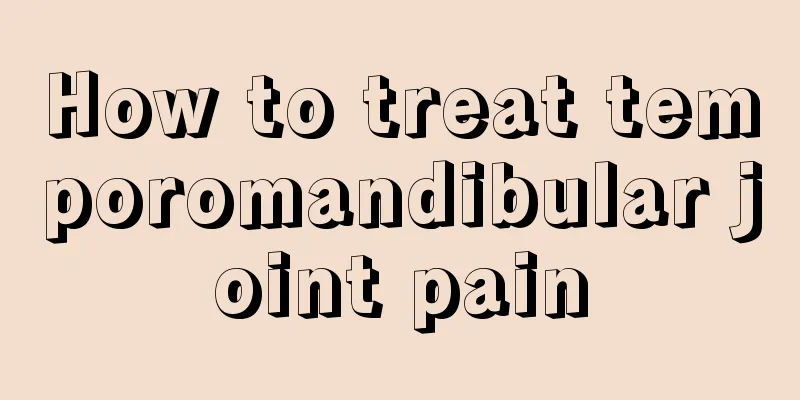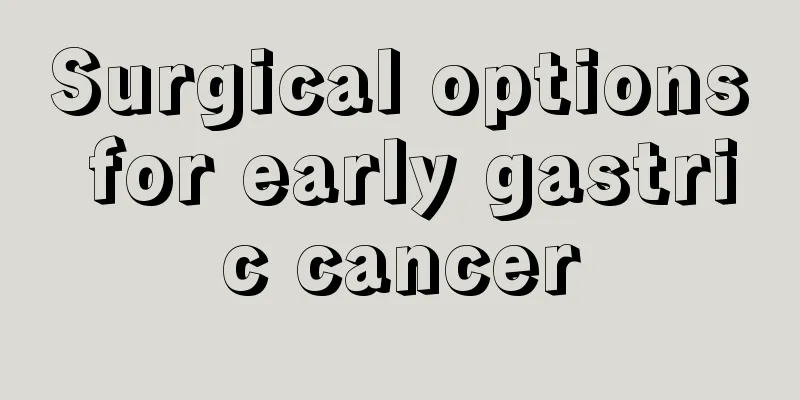How to treat temporomandibular joint pain

|
Temporomandibular joint pain may be related to many factors, such as mental stress from work and study, abnormal tooth occlusion function, asymmetric development of joints on both sides, etc. It may even easily cause symptoms such as dizziness and headache. So how should temporomandibular joint pain be treated? What are some good treatment measures and effective methods? Next, I will give you a detailed introduction. I hope that friends who are currently troubled by this situation can patiently read the content. If this disease occurs, you should pay attention to opening your mouth less, eating less hard food, talking less, and try to give the joints more rest. You can use a hot towel for hot compresses at home and massage the muscles near the joints. Temporomandibular arthritis Temporomandibular arthritis, commonly known as hook pain, refers to a syndrome of pain, movement disorders and other symptoms caused by dysfunction or structural damage of the temporomandibular joint. The pain is located deep in front of the ear and may radiate from there. The pain can spread to the entire side of the face, and is dull in nature and mild or moderate in severity. Activities such as chewing, talking, and clenching teeth can induce and aggravate the pain. Main clinical symptoms: (1) Joint popping is present in most cases, usually on one side, and sometimes accompanied by pain. (2) Joint pain mainly manifests as pain in the muscles around the joints when opening the mouth and chewing, without redness or swelling. The nature of the pain is dull pain, short-term stabbing pain, and there may be tenderness in the joints. (3) Abnormal mandibular movement. Abnormal opening degree, manifested as opening the mouth too wide or too narrow. The normal opening degree is about 3.7 cm on average. More than 4 cm is considered too wide, and less than 2 cm is considered too narrow. Abnormal opening type, manifested as deviation or distortion of the mandibular midline when opening the mouth. Sometimes the opening movement may lock. (4) Other symptoms include headache, dizziness, tinnitus, stuffy ears, blurred vision, eye swelling, difficulty swallowing, soreness and discomfort when chewing, etc. Cause of disease: The cause of this disease is complex and has not yet been fully understood. It is generally believed to be related to the following factors. ① Patients with temporomandibular joint dysfunction syndrome may have systemic symptoms such as anxiety, depression, psychological disorder, and insomnia. ②Examination of patients with this disease revealed that many had obvious occlusal disorders, such as premature cusp contact, missing posterior teeth, severe wear, and misplaced eruption of wisdom teeth. ③ Asymmetrical development of the joints on both sides, unilateral chewing habits causing excessive load on the joints, and accidental local injuries to the joints, etc. Precautions and treatment: Treatment principles of this disease: Since the cause and pathogenesis of this disease are not yet fully understood, there is still a lack of radical cure. 1. Eliminate all adverse mental and psychological factors, such as improving symptoms of neurasthenia, pointing out a good prognosis, enhancing confidence, and using sedatives and sleeping pills appropriately. 2. Avoid opening your mouth too wide, such as yawning or laughing, which may cause joint sprains. After being stimulated by cold, avoid sudden chewing movements to avoid muscle spasms and damage to joint ligaments. Correct bad chewing habits, such as unilateral chewing and clenching teeth at night. 3. Mouth opening exercises should be performed daily if mouth opening is restricted. Eliminate harmful stimuli, such as treating periodontitis, removing impacted wisdom teeth, repairing missing teeth, correcting malocclusion, etc. Change the unilateral chewing habit, avoid eating hard food, treat nocturnal bruxism, etc. 4. The lateral pterygoid muscle can be blocked. 5. Acupuncture therapy can be performed. 6. Calcium ion introduction can be performed. 7. Sedatives and antispasmodics can be taken orally. 8. Infrared, ultrashort wave, laser, wax therapy, massage and local hot compress, etc., also have certain therapeutic effects. 9. Do not perform excessive mouth opening and closing exercises, forward extension and lateral exercises, and experiments to see if there is any clicking or pain during the treatment: do not chew hard food. 10. If the temporomandibular joint is organically damaged and conservative treatment is ineffective, go to the hospital for surgical treatment. In daily life, you should pay attention to eating less hard food, it is best not to chew gum, and try not to open your mouth wide when yawning. It is recommended to go to the hospital for physical therapy. I hope you get well soon. |
<<: Nutritional recipes for patients with gastric tube insertion
Recommend
What are the treatments for pericarditis
Pericarditis is a common disease in life because ...
TCM Dietary Principles for Gallbladder Cancer
In the late stage of gallbladder cancer, symptoms...
Can applying honey lighten moles?
Moles are common on people's bodies, mainly c...
What does hypothyroidism mean?
Hypothyroidism refers to a syndrome caused by ins...
How long does it take for influenza A virus to heal?
In our daily lives, influenza viruses are most ac...
What are the consequences of tongue cancer recurrence
In recent years, the incidence of some uncommon d...
What is the cause of chest tightness and pain?
The chest is an important organ in the human body...
Cleaning stainless steel pots with baking soda
Stainless steel tableware has a smooth and beauti...
The cause of uterine cancer needs to be taken seriously by people
Uterine cancer is one of the most common tumor di...
How to take care of thyroid cancer scars
When caring for a thyroid cancer surgery scar, yo...
Yellow fluid oozes out of the wound after surgery
In daily life, we often get some diseases. With t...
Which hospital is best for children with nasopharyngeal cancer?
Nasopharyngeal cancer is a common disease in my c...
How to prevent polyps from turning into colon cancer
Various chronic intestinal diseases, such as ulce...
Can washing your face with sugar treat acne?
In daily life, most people have some pimples or p...
What is the probability of inheriting body odor?
Body odor is a disgusting disease, not because of...









